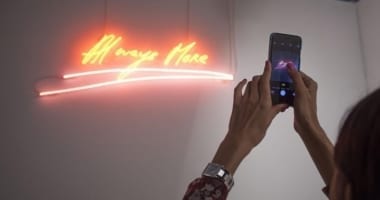As art becomes more accessible online, collectors have more ways than ever to buy, making it increasingly difficult for galleries to stand out and nurture their collector network. However, as the online art market increases (15% in 2016), you can leverage those channels to cultivate deep client relationships online that keeps collectors coming back to your gallery—and even make sales in the off-season.
List Your Complete Inventory Online
A brick-and-mortar space is no longer enough to cultivate a globally engaged collector network. Exhibitions are, by nature, limited in scope—foot traffic is finite and wall space is limiting.
Artsy’s Associate Director of Gallery Relations, explains that the more inventory you have online, the more discoverable your gallery is for collectors around the world.
“[Collectors] are exploring art online every day, scrolling through Artsy at 2 a.m. or inquiring on artworks while commuting to work. Making your backroom available to them online will attract interest—even while you sleep or your brick-and-mortar space is closed.”
Developing a gallery website is a great first step to communicate your brand to an online audience. As your gallery grows and you aim to attract more collectors, listing your inventory on third-party platforms like Artsy can further expand your visibility and create a commercial entry point for collectors.
A complete profile—including artwork images, prices, provenance, and more—can appeal to informed collectors currently looking to buy.
Build and Maintain an Email Database
Email is one easy way to stay in touch with your network of collectors—but to make this medium pay off, it’s best to tailor your outreach based on collector interest and engagement.
“Email fatigue is real. You have to think about how often you’re contacting collectors (and how often your competition is contacting them—you want to stand out). If you know a collector is interested in several of your artists, you’re going to be in touch with them a lot. Putting them on the general mailing list may not be the best idea,” says our associate director of gallery relations.
To send collectors more personal invitations and offers, you can maintain a spreadsheet or database of each collector and the works and artists they are interested in.
Artsy’s Associate Director of Collector Relations, also recommends categorizing those contacts as “soft leads, strong leads, or serious collectors.” These distinctions will make it easier to know who should be invited to different kinds of events; for example, an exhibition opening versus a studio visit or private dinner.

Send Personal, Targeted Communications
Recording collector interest in specific artists or types of art will also help you know who to contact when new work becomes available. Based on her experience working at Hasted Kraeutler, Artsy’s associate director suggests creating a list of every collector who’s ever bought from the gallery, what they’ve bought, and what they’ve inquired on. That information makes it easy to be very specific when extending invitations or making offers.
It’s also important to make sure your mass emails are going to an audience who wants to receive them. If a collector signed up for your communications on your website or in person, emailing regular updates makes sense. However, if you received their email address in a conversation that did not include consent to be added to an email list, it is best practice to not send them mass emails. Instead, focus on personal invitations, specific to that person and their interests.
Finally, we suggests making it easy for the recipient to inquire directly within the email—for galleries with websites that aren’t optimized for commercial engagement, this can take the form of a link to your Artsy profile or other online platform. “Artsy makes it easy to inquire,” Artsy’s associate director says. “If you want to turn some of that [interest into] commercial engagement, do it on Artsy.”

Courtesy of The Southern
Be Authentic
Being personal isn’t just tailoring your message to the collector — it’s also about making sure your communications reflect the brand and voice of your gallery, evoking the space, values and personality that your collectors recognize.
Erin Nathanson, co-owner of The Southern, recognizes the value of personalization. “Residing in the South keeps you grounded in how people communicate,” she said; “We have a couple different mailing lists, but we generally send correspondence to collectors directly.… We try to keep all information direct as well as personable.”
For Artsy, the best emails are the ones where “the template and design mimic the gallery’s personality; if you walk into the gallery and it’s an all-white box, their email is an all-white box.”
Erin had something very similar in mind when conceptualizing The Southern’s emails. “We begin every message with our custom typeface for The Southern—this script and coloration was created to mirror the neon sign which greets visitors in our gallery,” she noted. “Once a collector opens an email from The Southern, we hope it gives them the feeling of being in our brick and mortar.”
Connect with Collectors on the Go
Ease of access to inventory is not just for collectors. From art fairs and openings to private dinners and unplanned viewings, the faster you can share artwork information with a collector, the easier it will be to close a sale. Mobile apps with inventory management & messaging capabilities make any artwork accessible within seconds and on-brand emails one-click away.
Artsy gallery partners use Folio to follow up with collectors instantaneously at art fairs, preview new works or interesting acquisitions at private dinners, and even display backroom works in their brick-and-mortar spaces. Sales experiences can be convenient for collector and gallery alike—adopting mobile tools enables you to carry your gallery with you, wherever you go.



